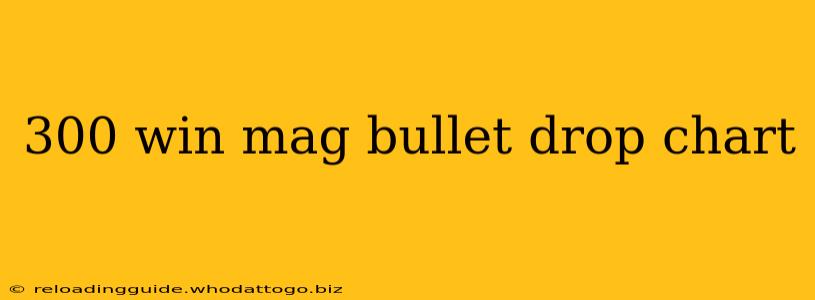The .300 Winchester Magnum (300 Win Mag) is a powerful cartridge known for its long-range capabilities, but accuracy depends heavily on understanding bullet drop. This isn't just about aiming higher; it's about accounting for gravity's effect on the projectile over distance. This guide will help you understand bullet drop charts and their importance for successful long-range shooting with your 300 Win Mag.
What is a Bullet Drop Chart?
A bullet drop chart visually represents the vertical distance a bullet falls below its initial trajectory at various ranges. It's crucial because a bullet fired horizontally doesn't travel in a straight line; gravity pulls it downwards. The further the bullet travels, the more pronounced this drop becomes. These charts typically account for several factors, including:
- Bullet weight: Heavier bullets generally have less drop than lighter ones due to their greater momentum.
- Muzzle velocity: Higher muzzle velocity translates to a flatter trajectory and reduced drop at longer ranges.
- Ballistic coefficient (BC): This measures a bullet's ability to overcome air resistance. Higher BC means less drop.
- Atmospheric conditions: Temperature, altitude, and humidity affect air density, influencing bullet trajectory.
How to Read a 300 Win Mag Bullet Drop Chart
A typical chart lists ranges (in yards or meters) in one column and the corresponding bullet drop (in inches or centimeters) in another. It might also include other vital data points such as:
- Zero Range: The distance at which the bullet's trajectory intersects the line of sight (where you aim). This is often 100, 200, or 300 yards.
- Windage: While not always included directly on the drop chart itself, wind significantly affects bullet trajectory, necessitating adjustments. Windage calculations require separate tools or estimations.
- Different Ammunition: Charts might show data for multiple bullet weights and types within the 300 Win Mag cartridge, highlighting the impact of bullet selection.
Factors Affecting Bullet Drop in 300 Win Mag
Beyond the standard factors, other elements influence your 300 Win Mag's bullet drop:
- Rifle twist rate: The rate at which the rifling in your barrel spins the bullet affects its stability and, consequently, its trajectory.
- Scope height: The height of your scope above the bore impacts the point of impact at various ranges.
- Sight-in process: Accurate zeroing of your scope is paramount for using a bullet drop chart effectively.
Finding and Using Your Bullet Drop Chart
You won't find a single, universally applicable 300 Win Mag bullet drop chart. The chart you need is specific to your ammunition and rifle setup. You can:
- Use a ballistic calculator: Many online calculators and apps (like Hornady's 4DOF, Ballistic AE, or similar) allow you to input your specific data (bullet weight, BC, muzzle velocity, etc.) to generate a custom chart.
- Consult your ammunition manufacturer's data: Look for information on their website or packaging. They might provide ballistic data or charts for their specific loads.
- Conduct your own field testing: While time-consuming, this method offers highly precise results tailored to your exact setup.
Conclusion
Mastering bullet drop is crucial for accurate long-range shooting with a 300 Win Mag. Understanding the factors involved, finding a chart that matches your specific ammunition and rifle, and considering external factors like wind will significantly improve your shooting accuracy and success rate at distance. Remember that consistent practice and responsible firearm handling are always paramount.

